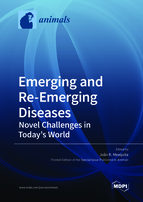Emerging and Re-Emerging Diseases—Novel Challenges in Today’s World
A special issue of Animals (ISSN 2076-2615). This special issue belongs to the section "Veterinary Clinical Studies".
Deadline for manuscript submissions: closed (31 March 2021) | Viewed by 52428
Special Issue Editor
2. EPIUnit–Instituto de Saúde Pública, Universidade do Porto, 4050-313 Porto, Portugal
Interests: transmissible diseases; zoonosis; epidemiology; infectious diseases
Special Issues, Collections and Topics in MDPI journals
Special Issue Information
Dear Colleagues,
More than 61% of all human pathogens are zoonotic, representing 75% of all emerging pathogens during the past decade. Although substantial developments in medical/environmental surveillance and in diagnostic methods have been recently achieved, zoonotic emerging and re-emerging diseases are still a major global concern. In fact, such threats are expanding under global warming conditions, particularly in less developed regions. The current 2019 novel coronavirus epidemic is an extreme reminder of the role animal reservoirs play in public health and highlights the need to address health risks at the animal–human–environment interface in a One Health perspective.
Original manuscripts that address any aspects of emerging or re-emerging animal diseases are invited for this Special Issue.
Prof. João R. Mesquita
Guest Editor
Manuscript Submission Information
Manuscripts should be submitted online at www.mdpi.com by registering and logging in to this website. Once you are registered, click here to go to the submission form. Manuscripts can be submitted until the deadline. All submissions that pass pre-check are peer-reviewed. Accepted papers will be published continuously in the journal (as soon as accepted) and will be listed together on the special issue website. Research articles, review articles as well as short communications are invited. For planned papers, a title and short abstract (about 100 words) can be sent to the Editorial Office for announcement on this website.
Submitted manuscripts should not have been published previously, nor be under consideration for publication elsewhere (except conference proceedings papers). All manuscripts are thoroughly refereed through a single-blind peer-review process. A guide for authors and other relevant information for submission of manuscripts is available on the Instructions for Authors page. Animals is an international peer-reviewed open access semimonthly journal published by MDPI.
Please visit the Instructions for Authors page before submitting a manuscript. The Article Processing Charge (APC) for publication in this open access journal is 2400 CHF (Swiss Francs). Submitted papers should be well formatted and use good English. Authors may use MDPI's English editing service prior to publication or during author revisions.
Keywords
- zoonosis
- infectious diseases
- parasitic diseases
- emerging







